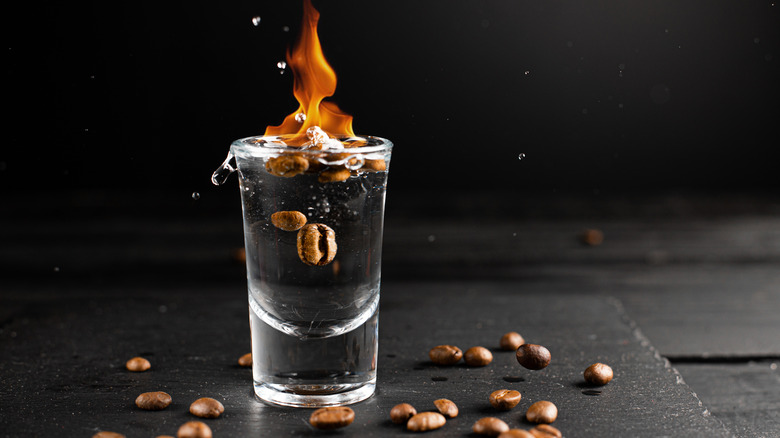Why Sambuca Is Garnished With 3 Coffee Beans In Italy
In any Italian drinking establishment, you're bound to see bottles of red, green, black, and white sambuca behind the bar. A neutral grain alcohol infused with star anise, sugar, and elderberry essential oils, sambuca is commonly served straight up with three coffee beans floating atop the shot. Far from being a simple garnish, the beans have additional significance.
The number three is very important for a multitude of reasons. In Christianity, it represents the Trinity between the Father, Son, and Holy Spirit. As Italy is a very Christian nation, the three coffee beans in sambuca could be representative of the nation's pride in its religion. However, there is also a more secular take on the number. Each of the three coffee beans is said to be for individual well-wishes. One bean is for happiness, one is for health, and one is for prosperity.
Beyond a symbolic meaning, the coffee beans do actually play a role in complimenting the flavor of the liqueur. Traditionally, once the sambuca is drained from the glass, it is customary to chew the soaked coffee beans. Doing this fully enhances the anise flavors of the sambuca, and cuts a bit of the acidity from the raw coffee beans. The drink can also be lit on fire, toasting the coffee beans for a few seconds. This is said to give them extra crispiness, additional flavor, and plenty of dramatic flare.
Other sambuca and coffee pairings
Sambuca and coffee or coffee beans are combined in a variety of other ways too. Perhaps most dramatically, in another rendition of the flaming sambuca that is a bit more over-the-top than simply lighting it on fire. For this, sambuca is served in a brandy snifter instead of the traditional shot glass. Then the booze is set alight for a few seconds, extinguished, and consumed. Being sure not to swallow the coffee beans, the snifter is turned over onto the counter of the bar to trap any remaining fumes. As the drinker chews the beans, the sniffer is lifted slightly and the fumes are inhaled with a straw. This is not a common occurrence, and no version of flaming sambuca should ever be tried at home.
Since coffee beans — jokingly referred to as "flies" — work well with sambuca simply floating atop the surface, it stands to reason that it would work well mixed into coffee too. In fact, for the reverse setup, there are a number of ways to add the liquor to your next coffee brew. Most simply, sambuca is commonly used as a replacement for sugar in espresso. The anise flavor compliments and sweetens the espresso, while also giving it an alcoholic kick. For a slightly fancier combination, there is another take on the classic Italian coffee cocktail known as a caffé corretto. Nothing more than espresso and alcohol, a caffé corretto is traditionally served with grappa. While this is more common in Northern Italy, sambuca or other anisette liqueurs are very popular farther south. So, whether it's for well wishes, drama, or flavor, coffee and sambuca make an excellent pairing.

